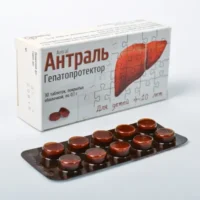Description
Silibor 35 (Silymarin) Coated Tablets 35 mg. №30
Ingredients
- Each coated tablet contains 35 mg of silymarin.
Dosage
- The recommended dosage is one tablet taken orally three times a day.
Indications
- Silibor 35 tablets are indicated for the treatment of liver disorders such as fatty liver, hepatitis, and cirrhosis.
Contraindications
- Do not use Silibor 35 if you are allergic to silymarin or any other ingredients in the product.
Directions
- Take Silibor 35 tablets with water, preferably before meals.
Scientific Evidence
Silibor 35 contains silymarin, a flavonoid with antioxidant and anti-inflammatory properties. Studies have shown that silymarin can protect liver cells from damage caused by toxins and promote regeneration of liver tissue.
Additional Information
- It is important to note that Silibor 35 should be used as part of a comprehensive treatment plan for liver disorders, including lifestyle modifications and other medications as prescribed by a healthcare professional.





